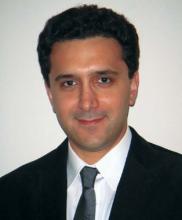Measles-containing vaccines are less likely to be associated with seizures when given at 12-15 months of age as recommended than when delayed until 16-23 months of age, according to results from a study published online Oct. 14 in JAMA Pediatrics.
In the retrospective cohort study examining the effect of age at immunization on 840,348 U.S. children given the MMR or MMRV vaccines during the second year of life in 2001-2011, "we found that the magnitude of increased risk of seizures following immunization with measles-containing vaccines during the second year of life depends on age.
"While measles-containing vaccines administered at 12-15 months of age are associated with an increased risk of seizures 7-10 days following immunization, their delayed administration at 16-23 months of age may result in an even greater increased risk of that adverse event following immunization," said Dr. Ali Rowhani-Rahbar of the department of epidemiology at the University of Washington, Seattle, and his associates.
The reason for this age-related difference in seizure risk is not yet known. It may simply be attributable to the fact that the background risk of seizures is higher in the older age group. Or a better-functioning immune system at the older age may allow children to mount a more rigorous immunologic response to the vaccine, raising the risk of febrile seizures.
It also is possible that vaccination is delayed among children thought to be susceptible to seizures for medical reasons, and that these children are more likely to develop seizures when they finally are vaccinated at the later age.
Regardless of the reasons for this age association, the increase in risk of seizures was very small for all age groups.
"Our findings are of direct relevance to the recommended childhood immunization schedule; they support the timely immunization of children with the first dose of measles-containing vaccine in accordance with current recommendations," the researchers noted.
Dr. Rowhani-Rahbar and his colleagues used data from the Centers for Disease Control and Prevention’s Vaccine Safety Datalink to examine this issue. The incidence of seizures was analyzed for each child during the 7- to 10-day "exposure period" following immunization and compared with the "control period" of the 42 days after that interval.
Then the rates of seizures were compared between children who were vaccinated at 12-15 months of age and those who were vaccinated at 16-23 months of age.
Overall, there were 1,810 seizure events during the 42 days following immunization, including 519 events (28.7%) that occurred during the 7- to 10-day exposure period.
The incidence of seizures during the control intervals was consistent with background rates reported in the general population. It also peaked at age 16-18 months, which is consistent with the peak that occurs in the general population.
The overall incidence of seizures was significantly higher during the exposure periods than the control intervals at all ages.
The most important finding was that the relative risk of seizures during the exposure interval was significantly greater among children vaccinated at 16-23 months of age (RR, 6.5) than among those vaccinated at 12-15 months of age (RR, 3.4) , the investigators reported (JAMA Pediatr. 2013 Oct. 14 [doi: 10.1001/jamapediatrics.2013.2745]).
The attributable risk was 9.5 excess cases of seizure per 10,000 doses given at 16-23 months of age, compared with 4.0 excess cases of seizure per 10,000 doses given at 12-15 months of age. These results remained robust in a sensitivity analysis of the data.
"These findings collectively suggest that the administration of measles-containing vaccines at the age of highest vulnerability to febrile seizures may result in an even greater increased risk of those adverse events following immunization," Dr. Rowhani-Rahbar and his associates said.
This study was supported by the CDC-sponsored Vaccine Safety Database through a subcontract with America’s Health Insurance Plans. Dr. Rowhani-Rahbar reported no financial conflicts of interest; his associates reported ties to GlaxoSmithKline, Merck, and other companies.


